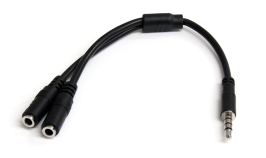Video Making on Android
Mobile video and audio techniques
This chapter gives tips both technical and artistic on how to get the best results when recording video on an Android device camera.
Shooting better video
  |
Hold your camera HORIZONTALLY, not vertically.
Image stabilisers on smartphones and tablets do not work as well as the Steady Shot on video camcorders. They can cause blurring when the shot moves. You need to practise holding the camera very steadily. Stand with your legs apart and lean on a wall if possible.
The Slingshot Smartphone Video Stabilizer (above) will fit any phone, costs around 25 euros, and is recommended.
Know where your lens is: and make sure your fingers do not get in front of it.
FOCUS: if your camera and subject are static, fix focus by tapping the screen. When the small box goes green, you have focus.
ZOOM: DO NOT do it on Android devices. The zoom function on phones and tablets is digital, not optical. Optical zoom means the lens elements are physically moved to get a closer shot. Digital zoom is more like the cropping of a photograph. Image definition diminishes the closer the shot zooms in. LG say they are planning optical zoom for their phones, but currently the only Android devices which have it are the digital cameras - the Samsung Galaxy Camera (21x) and the Nikon S800 (12x).
For shooting video on a mobile device, simplicity is always best. The templates in the next chapter encourage you to shoot video like a photo camera, with minimal movement.
Framing
 |
CLOSE-UP (CU)
|
| MEDIUM CLOSE-UP (MCU) | |
 |
MEDIUM SHOT or MID-SHOT (MS) |
| LONG SHOT (LS) | |
 |
TOO MUCH HEADROOM (it's easy to get this wrong)
|
 |
LOOKING SPACE - this is wrong. Give the person a space to look into. |
 |
LOOKING SPACE - give plenty of room in the direction the person is looking.
|
|
RULE OF THIRDS - Modern devices will have a "Rule of Thirds" grid plan over the video frame to help with framing. This framing ignores the thirds, and is unpleasing to the eye.
|
|
|
This framing is much more satisfying to look at. (Rule of Thirds images from wikipedia1)
|
Recording better audio
You can record a voice-over of acceptable quality while you operate the camera. Hold the device close to your mouth, and speak loudly and clearly. Every built-in microphone is different, so test it at varying volume levels and distances (perspectives). Play back and check that your voice is clear and dominant in the mix. Make sure you are not shouting. For audio recording, it especially helps to be in a quiet space.
For recording interviews, it is absolutely necessary to use an external microphone. Plug one in via the TRRS adapter (above)2, recommended in the Preparing to record chapter.
Always test that your mike is working with the adapter before recording. Record some voice with the microphone, and tap the mike with your fingers. Can you hear the finger taps when you play back through headphones? If not:
1. Check that the plug is fully in the jack. Take off the phone's cover in case this is impeding the plug. Test again.
2. Does your microphone have an on/off switch? Make sure it is turned on.
3. Does your mike take a battery? Try changing it.
NOTE: the TRRS adapter has two jacks, mic in and audio out (headphone). On the devices we have tested, the headphone socket CANNOT be used at the same time as the mic in socket. Record your test with the microphone plugged in, then remove it. Plug in the headphones to the other jack and play the recording back. You cannot simultaneously record and hear through the headphone socket, and if you leave the headphones plugged in during the recording, our tests show that the mike will be muted. The TRRS adapter works on all devices we have tested, except for the Samsung Galaxy Wonder. Please give us your feedback for your own device.
Recording on tablets
For video recording, tablets are essentially the same technologically as smartphones. The main differences are memory size (75GB or 100GB are standard), a larger screen, which is especially useful for editing, and a better battery. Recording on a tablet is more conspicuous, so may be more likely than a smartphone to cause you problems in sensitive situations.